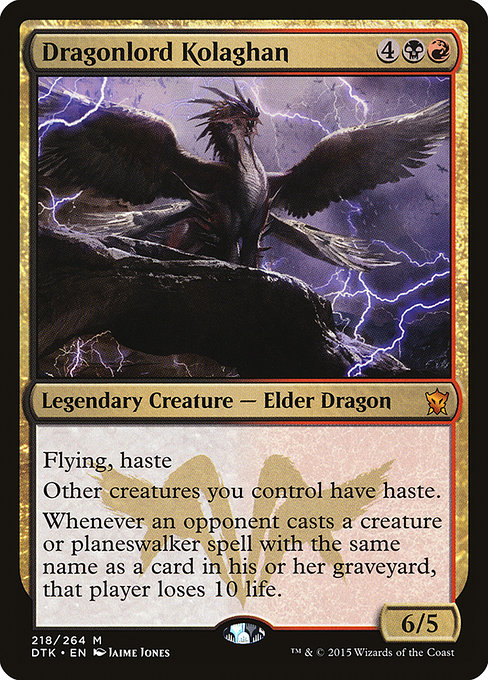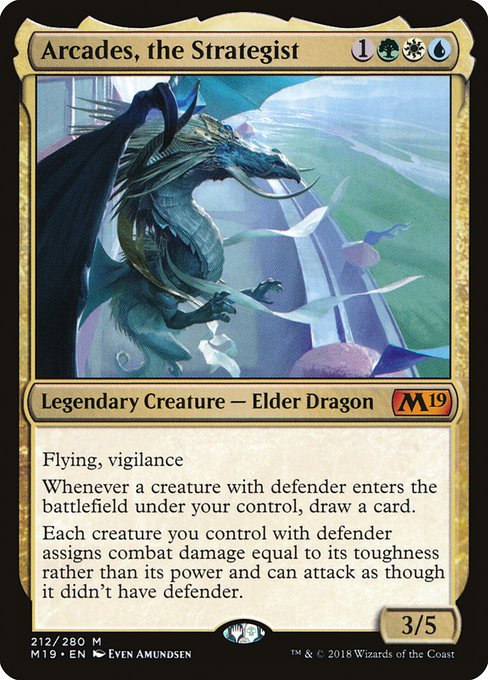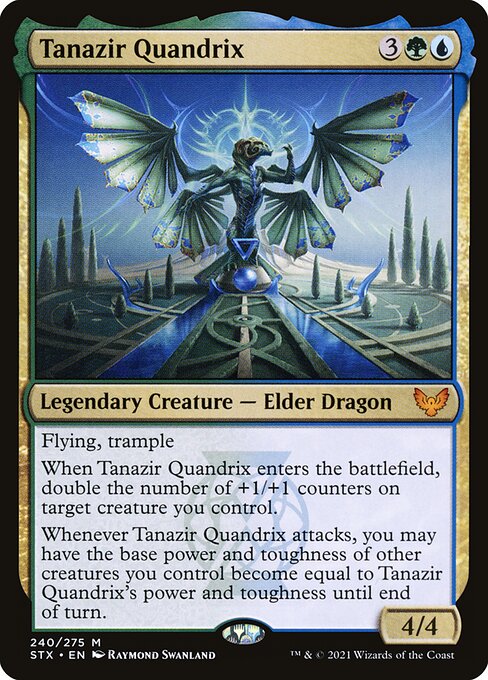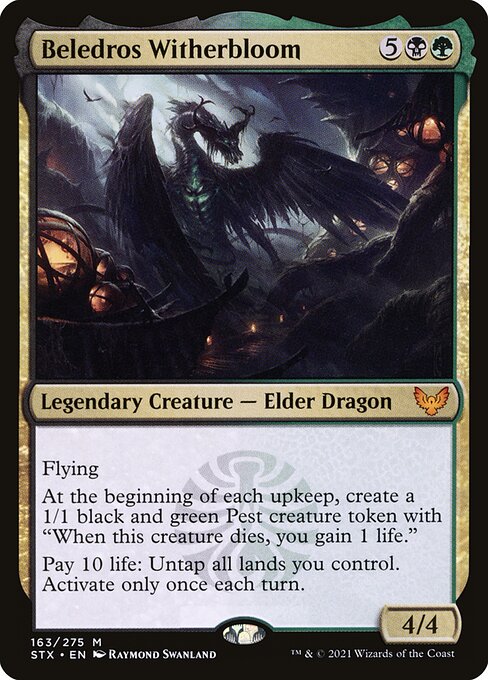Every old-school Magic player has one card they can point to that crystallized what they loved about Magic—some people were Force of Nature players or Shivan Dragon players or (in my case) Minion of Leshrac players. But there’s a core constituency of Magic who fell hard for the Elder Dragons in Legends, the ripple effect of which has affected the way we all play Magic (and thus the way Wizards designs Magic). These Elder Dragons have had an outsized influence on the game for cards that are effectively unplayable in the modern era and for cards that were printed twice in a year and then never again as a cycle.
The Elder Dragons cemented color identity early on, and they were later used to define one of Magic’s biggest success stories, when a group of judges started a pet format involving decks that were restricted to the colors of their chosen Elder Dragon. Polygon has a pretty comprehensive rundown of the format’s origins, but the important year to keep in mind is 2002—when Adam Staley introduced Sheldon Menery to his kitchen table format and Menery ran with the idea. Staley had been playing his version of EDH since 1996; it was Menery who introduced non-Elder Dragon creatures as viable commanders, which even then were still limited.
Fortuitously, Ravnica came out in 2005 and brought Commanders for each color combination, jump-starting the format at the precise right time for it to break into the mainstream and giving the Alaskan EDH group options to further fine-tune the format. Prior to 2005, for example, you couldn’t build a solely Blue-Green deck and White-Black was restricted to Selenia, Dark Angel. The format opened up at the precise right time to catch like wildfire, and was launched onto the web as Elder Dragon Highlander, or EDH. The format, even with dozens more generals than even a couple of years prior, was always tied to those five Legends Elder Dragons.
Part of the mystique that made Elder Dragon Highlander appealing came from the rarity of these five Dragons: Magic didn’t revisit the “Elder Dragon” creature type until Dragons of Tarkir. There were opportunities in those two decades to bring it back—the Invasion dragon cycle (Treva, Crosis, etc.) and the Planar Chaos dragon cycle (Teneb, etc.) weren’t Elder Dragons, even though they were primevally ancient, for example—but Wizards waited until Tarkir to push the type again. In 2013, Magic creative designer Doug Beyer classified it as “unsupported.”
I’m glad they waited to bring it back until it was thematically and mechanically useful—the “Elder Dragon” type is mythically resonant, and the Tarkir Dragonlords lived up to the appellation. There was some pushback, but Doug Beyer outlined the rationale on his blog and I think Sheldon Menery and Adam Staley would have been more than content with the cycle as new Commanders.

Dragonlord Ojutai and Dragonlord Atarka saw significant Standard play (with Dragonlord Silumgar seeing some counter play) and Dragonlord Dromoka is essentially the perfect big beater for a certain type of player. Dragonlord Kolaghan was the runt of the litter, as she wasn’t really qualified for Standard and her punishing ability is pretty useless in a singleton format. That said, the “Elder” type felt earned on all of these—they were the icons around which religions and societies coalesced, brought back from extinction by time travel and taking their place as the new/eternal rulers of Tarkir.
It didn’t take twenty years to revisit the Elder Dragon type: in M19, WotC went back to the game’s origins with the “Elder Dragon war” story from Legends-era and new, modernized versions of the Legends Elder Dragons. These updated Elder Dragons are pretty comical when directly compared to their older iterations—all upside, all the time, for minimal cost. Chromium, the Mutable for example, even were they just a 7/7 for 4WUB that could be played as an instant, would have obviated all other control finishers back in 1994 and would have made The Deck even more dominant than it was.

Personally, I think these updated Elder Dragons do a fantastic job of honoring the original five while making exciting, playable Commanders without pushing the format too far. Nicol Bolas, the Ravager was the only one that broke through in Standard, but perhaps that’s as it should be—the set was about him, not Palladia-Mors, the Ruiner. All of them were absurd bombs in Limited, of course, like the Tarkir Elders before them.
At the time M19 dropped, I was helping a couple of friends pick up the game, and their excitement over the Elder Dragons made it feel as though the game had come full circle, particularly when they went to Commander night at a local bar and came back asking why I hadn’t told them about the format. “Y’all’re in trouble—I cast Arcades” is a sentence that would be familiar to the Alaskan EDH playgroup back in 2002, and to hear that once more almost two decades later really brings home the advantages of the format.
This brings us to Strixhaven and the current crop of Elder Dragons. Before we dive into the deep end, let’s look at some stats. I’m not including Nicol Bolas’s Planeswalker side for this analysis, but treating him as a single-sided Elder Dragon. I am including the total cost, as it’s a helpful way to gauge mana “weight.”

Obviously, this isn’t the most precise way to analyze the Dragons—the Legends abilities balance out to basically neutral, while there’s no way to calculate the added value of some of the M19 or Strixhaven Dragons. I started off assigning a numerical value to each ability, but it’s hard to weight Nicol Bolas’s discard abilities when compared to Rampage 2 or creating a Treasure token and granting a durable ability to Treasures. So we’ll stick to stats for the moment, which I feel are relevant enough to gauge the effectiveness of each Elder Dragon.
Using standard rounding, the original Legends Elder Dragons have an average power of 7 and toughness of 7 with an average mana value of eight. No surprises there, considering they follow a 1:1 design trajectory. The Dragons of Tarkir Elder Dragons clock in as a 5/6 with a mana value of six, while the M19 Elder Dragons likewise average out to a 5/6 but with a mana value of five due to the two four-drop Elders. The Strixhaven Elder Dragons feel downright puny as a hypothetical 4/4 for six mana. Again, the numbers don’t tell the full story: Shadrix Silverquill plays more like a minimum of a 4/6 and Beledros Witherbloom adds some more (negligible) power to the board, but its illustrative of how Standard-safe the Strixhaven founders were designed to be after several years of tumult.

Strixhaven is Dragons of Tarkir 2.0—a cycle of Elder Dragons, a cycle of Commands, a couple of ability words that are apt to be as forgotten as Formidable and Exploit (which I would dearly love to return)—but Dragons of Tarkir was the culmination of a complete block, whereas Strixhaven has to pack everything in to one set, and to do so after two years of disruption to Magic, both internal and external. It’s a tough target to hit, and it leaves Strixhaven feeling disjointed and overstuffed, like a less obnoxious Dragon’s Maze.
Take, for example, how the new cycle of Commands feel like diluted versions of the Dragons of Tarkir commands. Compare Witherbloom Command to Kolaghan’s Command. Even typing that felt unfair, but that’s a parallel Wizards wanted us to draw with the nomenclature of the Commands. There’s nothing wrong with the Strixhaven Commands, it’s just that there’s no real breakout. We got five Ojutai’s Command or Silumgar’s Command without a Kolaghan’s or even an Atarka’s Command.
Contrast this to Ikoria’s Ultimatum cycle, which updated Shards of Alara’s cycle of Ultimata for the modern age. Emergent Ultimatum is perhaps a bit too open-ended in its puissance, but so was Cruel Ultimatum, and they were similarly dominant-but-defeatable in their respective Standard formats. It’s easy to judge designs after the fact, without the full context of the development cycle and the rigorous testing they go through; but it’s also worth calling out conservative designs as what they are, which is precisely what the Strixhaven Elder Dragons are.

Beledros Witherbloom is a hybridization of Verdant Force or Creakwood Liege and a dramatically nerfed Seedborn Muse—one that can be taken down by Demon Bolt or Languish. Commander decks with her at the helm seem to be bad Meren of Clan Nel Toth decks, and the fact that she costs seven mana keeps her out of Standard contention. She’s potent in your standard Golgari big-mana shell—untapping your Cabal Coffers and fueling big Exsanguinates—but the list of cards who are “potent Golgari big-mana” Commanders is already long. She’s one of the most expensive cards in Strixhaven, so obviously something about him speaks to the player base; but I’ve been left cold, even in Limited, where she often is outdone by massive Fractals or a squad of Inklings.
Galazeth Prismari is the most appealing to me for Standard play—a cheap, hefty flier that lets your Treasure tokens stick around is a solid card, especially in conjunction with Goldspan Dragon. But even then, he doesn’t feel like an omnipotent genius who has shaped the blue-red magic of an entire plane; he feels like another Izzet guild second-in-command. By the time he attacks for three for the first time on turn five, your opponent may have cast their own Goldspan Dragon or slapped an Embercleave on Questing Beast.
Velomachus Lorehold is the closest to an M19 Elder Dragon—multiple abilities that make them a nuisance in combat and a powerful attack trigger that gives you a free spell. That free spell is relatively situational, but Lorehold feels like a Bituminous Blast that swings for five (and even has vigilance so it can play double-duty). He’s the most generically powerful of the Strixhaven Dragons and the one that I feel best lives up to the promise of previous Elder Dragons.

Similarly, Shadrix Silverquill is the best designed Strixhaven Elder Dragon in a vacuum, because he’s the only one with any tension in his design. The others are simple cast-and-blast creatures, while the Silverquill founder makes you debate his benefits and drawbacks each turn. In Commander, it’s an intriguing political card, while in duel Magic, it’s a decent tool against control decks, where you can give them a useless anthem and yourself a Phyrexian Arena or give them nothing if a double-striking flier is enough to get there on its own.
Tanazir Quandrix is great in a deck built around Fractals or a generic +1/+1 counters deck. Absolutely nothing wrong with that—there’s a reason Doubling Season is one of the holy grails of casual and Commander—but it’s a bit win-more. In Standard, you’re not paying five mana for a restrictive boost to a creature or for a quirky Overrun with suspend 1. Definitely a consideration in the 99 for many decks, but I can’t imagine someone who is excited to build around the Quandrix leader.
The crux of my issue with the Strixhaven Elder quintet is simple: if these Elder Dragons were simply “Dragons,” I wouldn’t have any criticisms. They’d be Limited signposts and low-powered but interesting Commanders. But the simple addition of that label forces us to consider them as part of the legacy of the Elders that came before them and—unlike M19—I’m left disappointed.
There’s a simple (albeit possibly presumptuous) way to gauge the success of these latest Elders: as of May 15th, there are 714 registered Beledros Witherbloom (the most popular of the new Elder Dragons at #222) decks on EDHREC, compared to 2823 Arcades, the Strategist decklists or 1840 Nicol Bolas, the Ravager decks. Again, they’ve only been out for under two months, so this isn’t a one-to-one comparison; but it’ll be interesting to see how they fare as the game continues to evolve. Even with the “Elder Dragon” label, I just can’t shake the feeling that these are somehow lesser.
A lifelong resident of the Carolinas and a graduate of the University of North Carolina, Rob has played Magic since he picked a Darkling Stalker up off the soccer field at summer camp. He works for nonprofits as an educational strategies developer and, in his off-hours, enjoys writing fiction, playing games, and exploring new beers.
